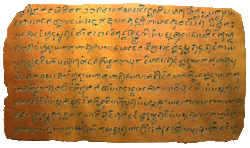Baybayin
Baybayin is a script which was used in the Middle Ages on the island of Luzon (today part of the Philippines). It is a syllabic script. Baybayin was used for Tagalog, Ilocano, and Pangasinan. It had already been in use in the 12th century, and was widely used before the Spanish colonial era (which started in the late 16th century). Baybayin is an abugida - every letter is a consonant. Spanish misssionaries used Baybayin to spread the Christian faith. The book Doctrina Christiana, en lengua española y tagala was one of the first Christian books printed, in 1592. The book is written in Tagalog, using Baybayin, and Spanish, using the Latin alphabet.
Each Baybayin letter is a consonant, forming a syllable ending in 'a', by default. To make syllables ending differently, a small symbol is added above the letter (to make it end in 'e' or 'i'), or below the letter, to make the syllable end in 'o' or 'u'. See how the symbol is used below:
This symbol is called kudlit, and is not used for vowels at the beginning of a word, which have their own letters.
The Hanunuo, Buhid, and Tagbanwa scripts resemble Baybayin, and are still in use today.
Today, there's an Unicode block for the Baybayin letters (called Tagalog).
Baybayin started to disappear in the 17th century. There was still poetry written in Baybayin until the 18th century. Today, most Philippine languages use the Latin script.
Baybayin Media
The Monreal stone, which is the centerpiece at the baybayin section of the National Museum of Anthropology
The Doctrina Christiana at the National Museum Of Anthropology
- Baybayin map philippines.jpg
The map of the Philippines in Baybayin
A Filipino dha sword inscribed with baybayin characters









